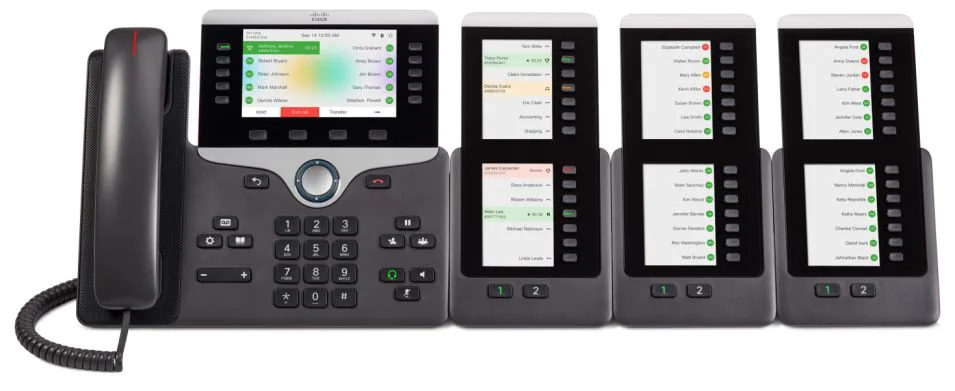Summary
- A vulnerability in the Cisco Discovery Protocol processing feature of Cisco IP Phone 7800 and 8800 Series firmware could allow an unauthenticated, adjacent attacker to cause a stack overflow on an affected device.This vulnerability is due to insufficient input validation of received Cisco Discovery Protocol packets. An attacker could exploit this vulnerability by sending crafted Cisco Discovery Protocol traffic to an affected device. A successful exploit could allow the attacker to cause a stack overflow, resulting in possible remote code execution or a denial of service (DoS) condition on an affected device.Cisco will release software updates that address this vulnerability. There are no workarounds that address this vulnerability.This advisory is available at the following link:
https://sec.cloudapps.cisco.com/security/center/content/CiscoSecurityAdvisory/cisco-sa-ipp-oobwrite-8cMF5r7U
Affected Products
- Vulnerable ProductsThis vulnerability affects the following Cisco products if they are running a vulnerable release of Cisco IP Phone firmware:
- IP Phone 7800 Series
- IP Phone 8800 Series (except Cisco Wireless IP Phone 8821)
Workarounds
- There are no workarounds that address this vulnerability. However, there is a mitigation that addresses this vulnerability for deployments that support both Cisco Discovery Protocol and Link Layer Discovery Protocol (LLDP) for neighbor discovery. Administrators may disable Cisco Discovery Protocol on affected IP Phone 7800 and 8800 Series devices. Devices will then use LLDP for discovery of configuration data such as voice VLAN, power negotiation, and so on. This is not a trivial change and will require diligence on behalf of the enterprise to evaluate any potential impact to devices as well as the best approach to deploy this change in their enterprise.While this mitigation has been deployed and was proven successful in a test environment, customers should determine the applicability and effectiveness in their own environment and under their own use conditions. Customers should be aware that any workaround or mitigation that is implemented may negatively impact the functionality or performance of their network based on intrinsic customer deployment scenarios and limitations. Customers should not deploy any workarounds or mitigations before first evaluating the applicability to their own environment and any impact to such environment.
Fixed Software
- Cisco will release free software updates that address the vulnerability described in this advisory. Customers with service contracts that entitle them to regular software updates should obtain security fixes through their usual update channels.Customers may only install and expect support for software versions and feature sets for which they have purchased a license. By installing, downloading, accessing, or otherwise using such software upgrades, customers agree to follow the terms of the Cisco software license:
https://www.cisco.com/c/en/us/products/end-user-license-agreement.htmlAdditionally, customers may only download software for which they have a valid license, procured from Cisco directly, or through a Cisco authorized reseller or partner. In most cases this will be a maintenance upgrade to software that was previously purchased. Free security software updates do not entitle customers to a new software license, additional software feature sets, or major revision upgrades.The Cisco Support and Downloads page on Cisco.com provides information about licensing and downloads. This page can also display customer device support coverage for customers who use the My Devices tool.When considering software upgrades, customers are advised to regularly consult the advisories for Cisco products, which are available from the Cisco Security Advisories page, to determine exposure and a complete upgrade solution.In all cases, customers should ensure that the devices to be upgraded contain sufficient memory and confirm that current hardware and software configurations will continue to be supported properly by the new release. If the information is not clear, customers are advised to contact the Cisco Technical Assistance Center (TAC) or their contracted maintenance providers.Customers Without Service ContractsCustomers who purchase directly from Cisco but do not hold a Cisco service contract and customers who make purchases through third-party vendors but are unsuccessful in obtaining fixed software through their point of sale should obtain upgrades by contacting the Cisco TAC: https://www.cisco.com/c/en/us/support/web/tsd-cisco-worldwide-contacts.htmlCustomers should have the product serial number available and be prepared to provide the URL of this advisory as evidence of entitlement to a free upgrade.Fixed ReleasesIn the following table(s), the left column lists Cisco software releases. The right column indicates whether a release is affected by the vulnerability that is described in this advisory and the first release that includes the fix for this vulnerability. Customers are advised to upgrade to an appropriate fixed software release as indicated in this section.
Source:
https://sec.cloudapps.cisco.com/security/center/content/CiscoSecurityAdvisory/cisco-sa-ipp-oobwrite-8cMF5r7U
Related posts
Categories
Critical vulnerabiliities (86)
cyber crime (1)
Cyber Security (67)
Data breach (2)
DER (11)
Exploit (30)
Hacks (79)
ICS (518)
Industrial IoT (IIoT) (29)
IoT Security (79)
Market (49)
News (1224)
Recommendations (59)
Remediation (7)
Reports (12)
Security Patches (12)
Standards (3)
Tools (6)
Uncategorized (30)
Vulnerabilities (1096)
White Papers (33)


Stay connected